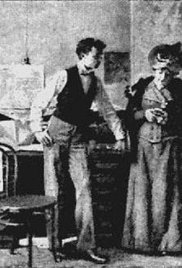|
Miss Jerry
Miss Jerry is an 1894 American feature-length black-and-white silent pre-film "Picture Play" written and produced by Alexander Black and starring Blanche Bayliss. Miss Jerry was not a film, but a series of posed magic lantern slides projected onto a screen with a dissolving stereopticon, accompanied by narration and music, making it the first example of a feature-length dramatic fiction on screen. Miss Jerry debuted on October 9, 1894 at the Carbon Studio in New York City. It has been described as "the first picture play" [1] and while other early film and peep-show animations produced at this time were short documentaries, Miss Jerry sought to develop what is arguably the first feature of moving pictures. This photoplay attempts to create an impression of movement with the slides changing once every 15 seconds. The Picture Play"In Miss Jerry my purpose has been to test experimentally, in a quiet story, certain possibilities of illusion, with this aim always before me, that the illusion should not, because it need not and could not safely, be that of photographs from an acted play, nor of artistic illustration, but the illusion of reality'." [2] Aware of the progress made by Eadweard Muybridge and other photographers towards the illusion of motion, Black instead set out to present a convincing narrative story in front of an audience, using still photography to present fiction in a convincing way, rather than a perfect illusion of motion. In his 1926 history of the movies, A Million and One Nights the author Terry Ramsaye says:
No intact set of slides for Miss Jerry is known to exist. PlotAfter finding out that her father is suffering financial problems, Jerry Holbrook decides to start a career in journalism in the heart of New York City. While working she falls in love with the editor of her paper, Walter Hamilton. After being offered a job in London, the couple initially have problems but Jerry accepts Walter's marriage proposal and they leave for London together. Cast
References
External links |
||||||||||||||||||||
